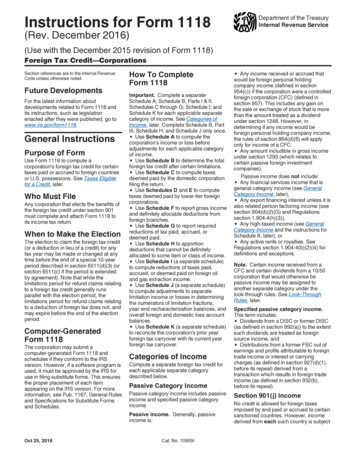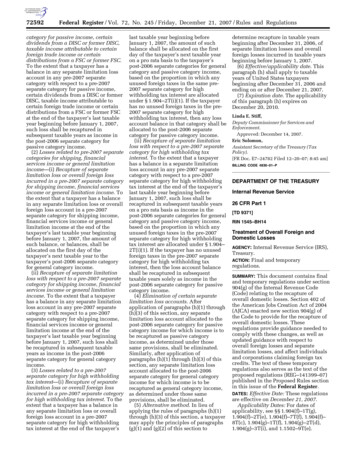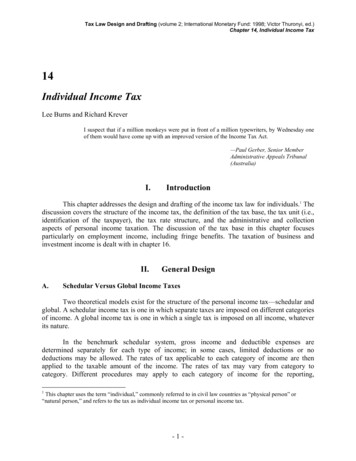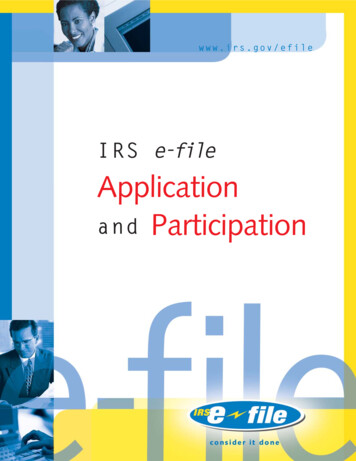
Transcription
Instructions for Form 1118(Rev. December 2016)Department of the TreasuryInternal Revenue Service(Use with the December 2015 revision of Form 1118)Foreign Tax Credit—CorporationsSection references are to the Internal RevenueCode unless otherwise noted.Future DevelopmentsFor the latest information aboutdevelopments related to Form 1118 andits instructions, such as legislationenacted after they were published, go towww.irs.gov/form1118.General InstructionsPurpose of FormUse Form 1118 to compute acorporation's foreign tax credit for certaintaxes paid or accrued to foreign countriesor U.S. possessions. See Taxes Eligiblefor a Credit, later.Who Must FileAny corporation that elects the benefits ofthe foreign tax credit under section 901must complete and attach Form 1118 toits income tax return.When to Make the ElectionThe election to claim the foreign tax credit(or a deduction in lieu of a credit) for anytax year may be made or changed at anytime before the end of a special 10-yearperiod described in section 6511(d)(3) (orsection 6511(c) if the period is extendedby agreement). Note that while thelimitations period for refund claims relatingto a foreign tax credit generally runsparallel with the election period, thelimitations period for refund claims relatingto a deduction of foreign tax does not, andmay expire before the end of the electionperiod.Computer-GeneratedForm 1118The corporation may submit acomputer-generated Form 1118 andschedules if they conform to the IRSversion. However, if a software program isused, it must be approved by the IRS foruse in filing substitute forms. This ensuresthe proper placement of each itemappearing on the IRS version. For moreinformation, see Pub. 1167, General Rulesand Specifications for Substitute Formsand Schedules.How To CompleteForm 1118Important. Complete a separateSchedule A; Schedule B, Parts I & II;Schedules C through G; Schedule I; andSchedule K for each applicable separatecategory of income. See Categories ofIncome, later. Complete Schedule B, PartIII; Schedule H; and Schedule J only once.Use Schedule A to compute thecorporation's income or loss beforeadjustments for each applicable categoryof income.Use Schedule B to determine the totalforeign tax credit after certain limitations.Use Schedule C to compute taxesdeemed paid by the domestic corporationfiling the return.Use Schedules D and E to computetaxes deemed paid by lower-tier foreigncorporations.Use Schedule F to report gross incomeand definitely allocable deductions fromforeign branches.Use Schedule G to report requiredreductions of tax paid, accrued, ordeemed paid.Use Schedule H to apportiondeductions that cannot be definitelyallocated to some item or class of income.Use Schedule I (a separate schedule)to compute reductions of taxes paid,accrued, or deemed paid on foreign oiland gas extraction income.Use Schedule J (a separate schedule)to compute adjustments to separatelimitation income or losses in determiningthe numerators of limitation fractions,year-end recharacterization balances, andoverall foreign and domestic loss accountbalances.Use Schedule K (a separate schedule)to reconcile the corporation's prior yearforeign tax carryover with its current yearforeign tax carryover.Categories of IncomeCompute a separate foreign tax credit foreach applicable separate categorydescribed below.Passive Category IncomePassive category income includes passiveincome and specified passive categoryincome.Passive income. Generally, passiveincome is:Oct 25, 2016Cat. No. 10905IAny income received or accrued thatwould be foreign personal holdingcompany income (defined in section954(c)) if the corporation were a controlledforeign corporation (CFC) (defined insection 957). This includes any gain onthe sale or exchange of stock that is morethan the amount treated as a dividendunder section 1248. However, indetermining if any income would beforeign personal holding company income,the rules of section 864(d)(6) will applyonly for income of a CFC.Any amount includible in gross incomeunder section 1293 (which relates tocertain passive foreign investmentcompanies).Passive income does not include:Any financial services income that isgeneral category income (see GeneralCategory Income, later),Any export financing interest unless it isalso related person factoring income (seesection 904(d)(2)(G) and Regulationssection 1.904-4(h)(3)),Any high-taxed income (see GeneralCategory Income and the instructions forSchedule A, later), orAny active rents or royalties. SeeRegulations section 1.904-4(b)(2)(iii) fordefinitions and exceptions.Note. Certain income received from aCFC and certain dividends from a 10/50corporation that would otherwise bepassive income may be assigned toanother separate category under thelook-through rules. See Look-ThroughRules, later.Specified passive category income.This term includes:Dividends from a DISC or former DISC(as defined in section 992(a)) to the extentsuch dividends are treated as foreignsource income, andDistributions from a former FSC out ofearnings and profits attributable to foreigntrade income or interest or carryingcharges (as defined in section 927(d)(1),before its repeal) derived from atransaction which results in foreign tradeincome (as defined in section 932(b),before its repeal).Section 901(j) IncomeNo credit is allowed for foreign taxesimposed by and paid or accrued to certainsanctioned countries. However, incomederived from each such country is subject
to a separate foreign tax credit limitation.Therefore, the corporation must use aseparate Form 1118 for income derivedfrom each such country. On each Form1118, check the box for section 901(j)income at the top of page 1 and identifythe applicable country in the spaceprovided.Sanctioned countries are thosedesignated by the Secretary of State ascountries that repeatedly provide supportfor acts of international terrorism,countries with which the United Statesdoes not have diplomatic relations, orcountries whose governments are notrecognized by the United States. As of thedate these instructions were revised,section 901(j) applied to income derivedfrom Iran, North Korea, Sudan, and Syria.For more information, see section 901(j).Note. Revenue Ruling 2016-8 providesthat, effective December 22, 2015, Cubais no longer a sanctioned country.Note. The President of the United Stateshas the authority to waive the applicationof section 901(j) with respect to a foreigncountry if it is (a) in the national interest ofthe United States and will expand tradeand investment opportunities for U.S.companies in such foreign country and (b)the President reports to the Congress, notless than 30 days before the waiver isgranted, the intention to grant such awaiver and the reason for such waiver.Note. Effective December 10, 2004, thePresident waived the application ofsection 901(j) with respect to Libya.If the corporation paid taxes to acountry that ceased to be a sanctionedcountry during the tax year, see Rev. Rul.92-62, 1992-2 C.B. 193, for details on howto figure the foreign tax credit for theperiod that begins after the end of thesanctioned period.Income Re-sourced by TreatyIf a sourcing rule in an applicable incometax treaty treats any U.S. source incomeas foreign source, and the corporationelects to apply the treaty, the income willbe treated as foreign source.Important. The corporation mustcompute a separate foreign tax creditlimitation for any such income for which itclaims benefits under a treaty, using aseparate Form 1118 for each amount ofre-sourced income from a treaty country.On each Form 1118, check the box forincome re-sourced by treaty at the top ofpage 1 and identify the applicable countryin the space provided. See sections865(h), 904(d)(6), and 904(h)(10) and theregulations under those sections(including Regulations section 1.904-5(m)(7)) for any grouping rules and exceptions.General Category IncomeThis category includes all income notdescribed above. This includes high-taxedincome that would otherwise be passivecategory income. Usually, income ishigh-taxed if the total foreign income taxespaid, accrued, or deemed paid by thecorporation for that income exceed thehighest rate of tax specified in section 11(and with reference to section 15, ifapplicable), multiplied by the amount ofsuch income (including the amount treatedas a dividend under section 78). For moreinformation, see Regulations section1.904-4(c). Also see the instructions forSchedule A, later, for additional reportingrequirements.This category also includes financialservices income (defined below) if thecorporation is a member of a financialservices group (as defined in section904(d)(2)(C)(ii)) or is predominantlyengaged in the active conduct of abanking, insurance, financing, or similarbusiness.Financial services income. Financialservices income is income received oraccrued by a member of a financialservices group or any corporationpredominantly engaged in the activeconduct of a banking, insurance,financing, or similar business, if theincome is:Described in section 904(d)(2)(D)(ii),Passive income (determined withoutregard to section 904(d)(2)(B)(iii)(II)), orIncidental income described inRegulations section 1.904-4(e)(4).Special RulesSource Rules for IncomeDetermine income or (loss) for eachseparate category on Schedule A usingthe general source rules of sections 861through 865 and related regulations; thespecial source rules of section 904(h)described below; and any applicablesource rules contained in any applicabletax treaties.Special source rules of section 904(h).Usually, the following income from aU.S.-owned foreign corporation, otherwisetreated as foreign source income, must betreated as U.S. source income undersection 904(h):Any subpart F income, foreign personalholding company income, or income froma qualified electing fund that a U.S.shareholder is required to include in itsgross income, if such amount isattributable to the U.S.-owned foreigncorporation's U.S. source income;Interest that is properly allocable to theU.S.-owned foreign corporation's U.S.source income; andDividends equal to the U.S. source ratio(defined in section 904(h)(4)(B)).-2-The rules regarding interest anddividends described above do not apply toa U.S.-owned foreign corporation if lessthan 10% of its E&P for the tax year is fromU.S. sources.Amounts That Do NotConstitute Income UnderU.S. Tax PrinciplesFor tax years beginning after December31, 2006, creditable foreign taxes that areimposed on amounts that do not constituteincome under U.S. tax principles aretreated as imposed on general categoryincome. See section 904(d)(2)(H).Look-Through RulesCFCs. Generally, dividends, interest,rents, and royalties received or accrued bythe taxpayer are passive category income.However, if these items are received oraccrued by a 10% U.S. shareholder from aCFC, they may be assigned to otherseparate categories under thelook-through rules of section 904(d)(3).This includes:Interest, rents, and royalties based onthe amount allocable to E&P of the CFC ina separate category andDividends paid out of the E&P of a CFCin proportion to the ratio of the CFC's E&Pin a separate category to its total E&P.Dividends include any amount included ingross income under section 951(a)(1)(B).Look-through rules also apply tosubpart F inclusions under section 951(a)(1)(A) to the extent attributable to E&P ofthe CFC in a separate category.For more information and examples,see section 904(d)(3) and Regulationssection 1.904-5.10/50 corporations. Generally,dividends received or accrued by thetaxpayer are passive category income.However, dividends received or accruedfrom a 10/50 corporation may be assignedto other separate categories under thelook-through rules of section 904(d)(4). A10/50 corporation is any foreigncorporation in which the taxpayer(domestic corporation) meets the stockownership requirements of section 902.See Regulations section 1.904-5(c)(4)(iii).Certain amounts paid by a U.S. corporation to a related corporation.Look-through rules also apply to foreignsource interest, rents, and royalties paidby a U.S. corporation to a relatedcorporation. See Regulations section1.904-5(g).Other RulesCertain transfers of intangible property. See section 367(d)(2)(C) for a rule thatclarifies the treatment of certain transfersof intangible property.Instructions for Form 1118 (2016)
Reporting Foreign TaxInformation From PartnershipsIf you received a Schedule K-1 from apartnership that includes foreign taxinformation, use the rules below to reportthat information on Form 1118.Gross income sourced at partner level.This includes income from the sale ofmost personal property other thaninventory, depreciable property, andcertain intangible property sourced undersection 865. This gross income willgenerally be U.S.-source and thereforewill not be reported on Form 1118.The remaining lines of the foreign taxsection of the Schedule K-1 are reportedon Form 1118 as follows:Foreign gross income sourced at partnership level. Report on Schedule A.Deductions allocated and apportionedat partner level and partnership level.Report on Schedule A or Schedule H.Total foreign taxes paid or accrued.Report on Schedule B.Reduction in taxes available for credit.Report on Schedule G.Capital GainsForeign source taxable income or (loss)before adjustments in all separatecategories in the aggregate should includegain from the sale or exchange of capitalassets only up to the amount of foreignsource capital gain net income (which isthe smaller of capital gain net income fromsources outside the United States orcapital gain net income). Therefore, if thecorporation has capital gain net incomefrom sources outside the United States inexcess of the capital gain net incomereported on its tax return, enter a pro rataportion of the net U.S. source capital lossas a negative number on Schedule A,column 9(d) for each separate categorywith capital gain net income from sourcesoutside the United States. To figure thepro rata portion of the net U.S. sourcecapital loss attributable to a separatecategory, multiply the net U.S. sourcecapital loss by the amount of capital gainnet income from sources outside theUnited States in the separate categorydivided by the aggregate amount of capitalgain net income from sources outside theUnited States in all separate categorieswith capital gain net income from sourcesoutside the United States.See section 904(b)(2)(B) for specialrules regarding adjustments to account forcapital gain rate differentials (as defined insection 904(b)(3)(D)) for any tax year. Atthe time these instructions went to print,there was no capital gain rate differentialfor corporations.Instructions for Form 1118 (2016)Credit LimitationsTaxes Eligible for a CreditDomestic corporations. Generally, adomestic corporation may claim a foreigntax credit (subject to the limitation ofsection 904) for the following taxes:Income, war profits, and excess profitstaxes (defined in Regulations section1.901-2(a)) paid or accrued during the taxyear to any foreign country or U.S.possession;Taxes deemed paid under sections 902and 960; andTaxes paid in lieu of income taxes asdescribed in section 903 and Regulationssection 1.903-1.Some foreign taxes that are otherwiseeligible for the foreign tax credit must bereduced. These reductions are reportedon Schedule G.Note. A corporation may not claim aforeign tax credit for foreign taxes paid to aforeign country that the corporation doesnot legally owe, including amounts eligiblefor refund by the foreign country. If thecorporation does not exercise its availableremedies to reduce the amount of foreigntax to what it legally owes, a credit is notallowed for the excess amount.Foreign corporations. Foreigncorporations are allowed (under section906) a foreign tax credit for income, warprofits, and excess profits taxes paid oraccrued (or deemed paid under section902) to any foreign country or U.S.possession for income effectivelyconnected with the conduct of a trade orbusiness within the United States. Thecredit is not applicable, however, if aforeign country or U.S. possessionimposes the tax on income from U.S.sources solely because the foreigncorporation was created or organizedunder the law of the foreign country orU.S. possession or is domiciled there fortax purposes.The credit may not be taken againstany tax imposed on income not effectivelyconnected with a U.S. business.In computing the foreign tax creditlimitation, the foreign corporation's taxableincome includes only the taxable incomethat is effectively connected with theconduct of a trade or business within theUnited States.A foreign corporation claiming a foreigntax credit will be treated as a domesticcorporation in computing tax deemed paid(section 902(a)) and dividend gross-up(section 78).Definition of foreign corporation forpurposes of the deemed paid credit. Incomputing the deemed paid credit onSchedules C, D, and E, the term “foreigncorporation” includes:-3-A DISC or former DISC, but only fordividends from the DISC or former DISCthat are treated as income from sourcesoutside the United States andA contiguous country life insurancebranch that has made an election to betreated as a foreign corporation undersection 814(g).Credit or DeductionA corporation may choose to take either acredit or a deduction for eligible foreigntaxes paid or accrued. The choice is madeannually. Generally, if a corporation electsthe benefits of the foreign tax credit for anytax year, no portion of the foreign taxeswill be allowed as a deduction in that yearor any subsequent tax year.Exceptions. However, a corporation thatelects the credit for eligible foreign taxesmay be allowed a deduction for certaintaxes for which a credit was not allowed.These include:Taxes for which the credit was deniedbecause of the boycott provisions ofsection 908.Certain taxes on the purchase or sale ofoil or gas (section 901(f)).Certain taxes used to provide subsidies(section 901(i)).Taxes paid to certain foreign countriesfor which a credit was denied undersection 901(j).Certain taxes paid on dividends if theminimum holding period is not met withrespect to the underlying stock, or if thecorporation is obligated to make relatedpayments with respect to positions insimilar or related property (section 901(k)).Certain taxes paid on gain and incomeother than dividends if the minimumholding period is not met with respect tothe underlying property, or if thecorporation is obligated to make relatedpayments with respect to positions insimilar or related property (see section901(l)).In the case of a covered assetacquisition (as defined in section 901(m)(2)), the disqualified portion of any taxdetermined with respect to the income orgain attributable to the relevant foreignassets (section 901(m)). Note. This rulegenerally applies to covered assetacquisitions after December 31, 2010.No Credit or DeductionNo foreign tax credit (or deduction) isallowed for certain taxes including:Taxes on mineral income that werereduced under section 901(e).Certain taxes paid on distributions frompossessions corporations (section901(g)).Taxes on combined foreign oil and gasincome that were reduced under section907(a).Taxes attributable to income excludedunder section 814(a) (relating to
contiguous country branches of domesticlife insurance companies).Taxes paid or accrued to a foreigncountry or U.S. possession with respect toincome excluded from gross income onForm 8873, Extraterritorial IncomeExclusion. However, see section 943(d)for an exception for certain withholdingtaxes.Carryback and Carryforward ofExcess Foreign TaxesIf the allowable foreign taxes paid,accrued, or deemed paid in a tax year in aseparate category exceed the foreign taxcredit limitation for the tax year for thatseparate category, the excess may be:Carried back 1 year to offset taxesimposed in the same category.Carried forward 10 years to offset taxesimposed in the same category.The excess is applied first to theearliest of the years to which it may becarried, then to the next earliest year, etc.The corporation may not carry a credit to atax year for which it claimed a deduction,rather than a credit, for foreign taxes paidor accrued. Furthermore, the corporationmust reduce the amount of any carrybackor carryforward by the amount it wouldhave used if it had chosen to claim a creditrather than a deduction in that tax year.See section 904(c) and Regulationssection 1.904-2 for more details.How to claim the excess credit. If thecorporation is carrying back the excesscredit to an earlier year, file an amendedtax return with a revised Form 1118 andschedules (including a revised Schedule K(Form 1118)).Special rules apply to:The carryback and carryover of foreigntaxes paid or accrued on combinedforeign oil and gas income or related taxes(see section 907(f)) andAn excess foreign tax credit for whichan excess limitation account wasestablished under section 960(b)(2).Special rules for carryforwards ofpre-2007 unused foreign taxes. Theforeign taxes carried forward generally areallocated to the post-2006 separatecategories to which those taxes wouldhave been allocated if the taxes were paidor accrued in a tax year beginning after2006. Alternatively, the corporation canallocate unused foreign taxes in itspre-2007 passive income category to thepost-2006 separate category for passivecategory income, and can allocate allother unused foreign taxes in pre-2007separate categories that were eliminatedin 2007 to the post-2006 separatecategory for general category income.Treaty-Based ReturnPositionsCorporations that adopt a return positionthat any U.S. treaty overrides or modifiesany provision of the Internal RevenueCode, and causes (or potentially causes)a reduction of any tax incurred at any time,generally must disclose this position.Complete Form 8833, Treaty-BasedReturn Position Disclosure Under Section6114 or Section 7701(b), and attach it toForm 1118. See section 6114 andRegulations section 301.6114-1 fordetails.Failure to make such a report mayresult in a 10,000 penalty.Proof of CreditsForm 1118 must be carefully filled in withall the information called for and with thecalculations of credits indicated.Important. Documentation (that is,receipts of payments or a foreign taxreturn for accrued taxes) is not required tobe attached to Form 1118. However, proofmust be presented upon request by theIRS to substantiate the credit. SeeRegulations section 1.905-2.If the corporation claims a foreign taxcredit for tax accrued but not paid, the IRSmay require a bond to be furnished onForm 1117, Income Tax Surety Bond,before the credit is allowed. SeeRegulations section 1.905-2(c).Foreign Tax CreditRedeterminationsThe corporation's foreign tax credit andU.S. tax liability generally must beredetermined if:Accrued foreign taxes when paid differfrom the amounts claimed as credits;Accrued foreign taxes are not paidwithin 2 years after the close of the taxyear to which they relate; orAny foreign tax paid is fully or partiallyrefunded.Except as provided in TemporaryRegulations section 1.905-3T(d)(3), aredetermination of U.S. tax liability is notrequired to account for the effect of aredetermination of foreign tax paid oraccrued by a foreign corporation on theamount of foreign taxes deemed paidunder section 902 or 960. Instead, theforeign corporation's pools of E&P andforeign taxes are adjusted in the year ofthe foreign tax redetermination.Reporting RequirementsIf the corporation must redetermine itsU.S. tax liability, the corporation must:File an amended return and Form 1118with the Service Center where it filed thetax return on which it claimed the affectedforeign tax credit and-4-Provide identifying information such asthe corporation's name, address,employer identification number (EIN), andthe tax year or years that are affected bythe redetermination.Additional information required. If theredetermination was because of one of thefollowing, the corporation must provide theadditional information as indicated.Refund of foreign taxes paid—1. The date or dates on which theforeign taxes were accrued, paid, andrefunded;2. The amount of foreign taxesaccrued, paid, and refunded on each date(in foreign currency); and3. The exchange rates used totranslate such amounts.Foreign taxes that when paid differfrom the accrued amounts claimed ascredits for a year beginning before1998—1. The date on which the foreign taxeswere accrued;2. The dates on which the foreigntaxes were paid;3. The exchange rate for each datethe foreign taxes were accrued and paid;and4. The amount of foreign taxesaccrued or paid on each such date (inforeign currency).Foreign taxes that when paid differfrom accrued amounts claimed ascredits for a tax year beginning after1997 because the corporation paidmore or less foreign tax than wasoriginally accrued or failed to payaccrued taxes within 2 years—1. The date on which the foreign taxeswere accrued;2. The dates on which the foreigntaxes were paid;3. The average exchange rate for theyear for which the foreign taxes wereaccrued;4. For taxes paid more than 2 yearsafter the year to which they relate, theexchange rate at the time of payment; and5. The amount of tax accrued or paidfor each such date, and the amount ofaccrued tax that was not paid within 2years (in foreign currency).Foreign taxes deemed paid undersection 902 or 960—If the corporation isrequired to make a redetermination underTemporary Regulations section1.905-3T(d)(3), include the following basicinformation as an attachment to the taxreturn for the year for which theredetermination applies:1. The dates and amounts of anydividend distributions or other inclusionsfrom E&P for the affected year or years;Instructions for Form 1118 (2016)
2. The amount of E&P from whichsuch dividends were paid for the affectedyear or years;3. The current balances of the poolsof E&P and foreign taxes before and afterthe foreign tax adjustment; and4. The information described abovefor foreign taxes paid or accrued, asapplicable.If foreign taxes deemed paid undersections 902 or 960 are adjusted and thecorporation is not required to redetermineits U.S. tax liability, adjust the appropriatepools of foreign taxes and E&P using therules outlined in Temporary Regulationssections 1.905-3T(d)(2)(ii) and1.905-4T(b)(2).Amended returns for all years affectedby foreign tax redeterminations that resultin U.S. tax deficiencies and that occurredin the three tax years immediatelypreceding the corporation's first tax yearbeginning on or after November 7, 2007(and tax years of foreign subsidiariesending with or within such tax years oftheir domestic corporate shareholders),are due no later than the due date (withextensions) of the corporation's return forits second tax year beginning on or afterNovember 7, 2007. Amended returns forall years affected by foreign taxredeterminations that result in U.S. taxdeficiencies and that occur in tax yearsbeginning after November 7, 2007 (andtax years of foreign subsidiaries endingwith or within such tax years of theirdomestic corporate shareholders), aredue no later than the due date (withextensions) of the corporation's return forits tax year in which the foreign taxredetermination occurs. For special rulesrelating to corporations under thejurisdiction of the Large Business &International Division, see TemporaryRegulations sections 1.905-4T(b)(3) and1.905-4T(f)(2)(iii).Interest and PenaltiesSeparate Categoryof Income BoxesThe corporation must complete a separateForm 1118 for each applicable category ofincome. See Categories of Income,earlier.Schedule AReport gross income or (loss) fromsources outside the United States for theapplicable separate category in columns 2through 7. Gross income equals grossreceipts reduced by cost of goods sold.Report the applicable deductions to thisgross income in columns 9 and 10. Reportany net operating loss carryover in column11. Be sure to include in all columns thegross income and deductions that pertainto foreign branches.Section 863(b) gross income and deductions. Aggregate all section 863(b)gross income and deductions and reportthe totals on a single line. It may benecessary to enter amounts in multiplecolumns on that single line, dependingupon the nature of the section 863(b)gross income and deductions. Forexample, enter “863(b)” in column 1 andenter (as a positive number) all section863(b) gross income (in columns 2through 8) and all section 863(b)deductions (in columns 9a through 12).Also enter the net amount in column 13.Note that the totals are being reported ona single line because it is not necessary toreport section 863(b) gross income anddeductions on a per-country basis.RIC pass-through amounts. Aggregateall income passed through from regulatedinvestment companies (RICs) and reportthe total on a single line. Enter “RIC” incolumn 1 and report the total in column 13.Note that the totals are being reported ona single line because it is not necessary toreport the RIC pass-through amounts on aper-country basis.In most cases, interest is computed on thedeficiency or overpayment that resultedfrom the foreign tax adjustment (sections6601 and 6611 and the relatedregulations). See Temporary Regulationssection 1.905-4T(e) for additionalinformation.Net operating losses. Report any netoperating loss carryover on a single line.Enter “NOL” in column 1 and report thetotal in column 11. Note that the totals arebeing reported on a single line because itis not necessary to report the NOL on aper-country basis.If the corporation does not comply withthe requirements discussed above withinthe time for filing specified, the penaltyprovisions of section 6689 (and the relatedregulations) will apply.Reclassifications of high-taxed income. Aggregate all reclassifications ofhigh-taxed income and report the total ona single line. With respect to passivecategory income, for items of income thathave been included on Schedule A andthat must be reclassified under the rules ofRegulations sec
Passive income. Generally, passive income is: Any income received or accrued that would be foreign personal holding company income (defined in section 954(c)) if the corporation were a controlled foreign corporation (CFC) (defined in section 957). This includes any gain on the sale or exchange of stock that is more than the amount treated as a .










